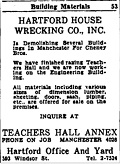What's that you say, someone has erected a large building in the middle of Miss Case's archery field while you weren't looking! A fine how-do-you-do! Well, actually you are looking at an early 1900s photograph that shows what was known as Teachers' Hall residing in the now vacant field between the Manchester High School building we, the class of 1955 attended, and the South United Methodist Church parsonage.
�The Harper�s New Monthly magazine of November 1892, in an article entitled �An Industrial Experiment at South
Manchester,� gives South Manchester the credit of being the �seat of the introduction of silk weaving in the United States.�
Cheney Bros. was the experimenter.�
�By 1889 there were nine teachers in the Ninth School District, the area of South Manchester surrounding the mills.�
Over the years, the number of teachers grew and housing them became a concern. Thus evolved what became known as Teachers�
Hall, a long building which stood just south of the old High School. Teachers were expected to keep their own rooms ready
for �white glove� inspections. ��.Ample, nutritious, and well-balanced meals were served.� The residents had to observe a
curfew of 11 p.m., and the article mentions how some enterprising teachers either climbed in first-floor windows or used
the fire escape to reach upper floors. Hm-m-m�.some things never change!!
[Ed. Note: Mention is also made of this facet of Teachers' Hall in the article
An Interview with "Mrs. Maher".]
The detailed description of the interior sounds rather inviting and well planned. The bedrooms themselves sounded
rather like college dorm rooms, sparse but amply furnished, with curtains, etc., provided by the residents. The dining room
was furnished with round tables seating 12, and the teachers were provided with 3 meals a day. Wednesday s and Sundays were
�dress for dinner� occasions, with dinner always served promptly at 6 p.m.
�Teachers took their responsibilities seriously and earnestly did many hours of work at home. The level of loyalty,
morale and esprit de corps was high.�
In the early 1900s, Cheney Brothers hired some college graduates to work in their offices, and those girls made their
homes with the teachers in Teachers� Hall. The article further mentions that the facility housed �about eighty individuals.�
�A disturbing factor arose in 1924-25 when Cheney Bros. discontinued their support which had been the payment of about
two thousand dollars toward maintenance. Their responsibility was then assumed by the teachers themselves. Board was
increased $1.25 per week. � (This was an increase from the average price of $8.25 per week! What would that be in today�s
inflated economy??)
Around this same time, things became less strict and structured in the Hall due to the absence of training students;
a more hotel-like atmosphere was evident. There was great excitement for a period around 1930 when men began living in the
facility. They were designers, chemists, mathematicians, newspaper reporters, and efficiency men; even a family moved into
an area close by at the south side of the Hall. �Integration of the two groups must have been successful as friendships
developed in a few cases, leading later to marriages.� Told you�..some things just never change!!
�In April of 1932�..all the schools came under the control of the Town Board of Education. The days of Teachers� Hall
were numbered. In December of 1932 it was closed, and not long after the building was demolished [Webmaster's note: the building was demolished in 1935 by the Hartford House Wrecking Company]. Thus ended the history of
a unique institution, a home away from home, one where parents felt safe in sending their young and inexperienced daughters
to begin the career of teaching.�
of Teachers� Hall
were numbered. In December of 1932 it was closed, and not long after the building was demolished [Webmaster's note: the building was demolished in 1935 by the Hartford House Wrecking Company]. Thus ended the history of
a unique institution, a home away from home, one where parents felt safe in sending their young and inexperienced daughters
to begin the career of teaching.�
Editorial license taken here�.this, to me (Sandy Jenkins) sounds like a delightful experience for the many young
women who lived in Teachers� Hall. Certainly all of their needs were met and, other than general housekeeping duties, time
was available for social activities, study, and the generally varied �trials and tribulations� of growing up!
Reproduced 2011 from www.mhs1955.com with permission of its webmaster Dick Jenkins.
All content ©